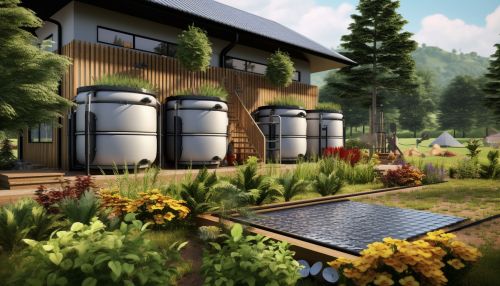Rainwater harvesting
Introduction
Rainwater harvesting is the accumulation and storage of rainwater for reuse on-site, rather than allowing it to run off. It provides an independent water supply during regional water restrictions and in developed countries is often used to supplement the main supply. It provides water when a drought occurs, can help mitigate flooding of low-lying areas, and reduces demand on wells which may enable ground water levels to be sustained. It also helps in the availability of potable water, as rainwater is substantially free of salinity and other salts. Applications of rainwater harvesting in urban water system provides a substantial benefit for both water supply and wastewater subsystems by reducing the need for clean water in water distribution systems, less generated stormwater in sewer systems, and a reduction in stormwater runoff polluting freshwater bodies.


History
The harvesting of rainwater simply involves the collection of water from surfaces on which rain falls, and subsequently storing this water for later use. Normally water is collected from the roofs of buildings and stored in rainwater tanks. Water can also be collected in dams from rain falling on the ground and producing runoff. This type of system can harvest much larger amounts of water, but it is more complex to install and maintain. In some cases, rainwater may be the only available, or economical, water source. Rainwater harvesting systems can be simple to construct from inexpensive local materials, and are potentially successful in most habitable locations. Roof rainwater is usually of good quality and does not require treatment before consumption. Although some rooftop materials may produce rainwater that is harmful to human health, it can be useful in flushing toilets and washing clothes. Because rainwater systems are simple to construct and use, they are also used in poor areas where local water resources are not sufficient.
Techniques and Practices
Rainwater harvesting techniques vary widely, depending on the end-use of collected water and the context of the practice. The following are some of the common methods of rainwater harvesting:
Roof Catchment Systems
The roof is the first catchment area in a rainwater harvesting system. It is the structure that intercepts the rainfall first. The size and type of the roof greatly affect the amount of rainwater that can be harvested. For instance, a roof that is 1,000 square feet can collect around 600 gallons of water during a one-inch rainfall. The material of the roof is also important. Certain materials, like metal, are more suitable for rainwater harvesting because they are smooth and allow maximum water flow. Other materials, like clay or concrete, may absorb some water, but they also collect significant amounts.
Ground Catchment Systems
Ground catchment systems collect rainwater directly from the ground surface. They are typically used in areas where rainfall is heavy, but the evaporation rate is also high. The ground surface is made impermeable so that the rainwater flows into a collection channel instead of being absorbed into the ground. The collected water is then stored in a reservoir.
Rainwater Harvesting Tanks
Rainwater harvesting tanks, also known as cisterns, are used to store rainwater for later use. They can be as simple as a small barrel that collects runoff from a downspout, or as complex as a large underground cistern with pumps and filtration systems. The size and complexity of a rainwater tank will depend on the amount of rainfall that can be collected and the intended use of the water.
Benefits of Rainwater Harvesting
Rainwater harvesting provides numerous benefits, both economic and environmental. Some of the key benefits include:
Water Conservation
Rainwater harvesting helps conserve water by reducing the demand for municipal water. It can provide an alternative water source during periods of drought or when groundwater supplies are depleted.
Reducing Water Bills
By using harvested rainwater for non-potable uses such as irrigation, toilet flushing, and laundry, households can significantly reduce their water bills.
Reducing Stormwater Runoff
Rainwater harvesting reduces stormwater runoff by diverting rainwater into storage tanks. This can help reduce the risk of flooding and soil erosion.
Promoting Water Sustainability
By reducing the demand for municipal water and reducing reliance on groundwater, rainwater harvesting promotes water sustainability.
Challenges and Considerations
While rainwater harvesting provides numerous benefits, there are also some challenges and considerations that need to be taken into account. These include:
Quality of Rainwater
The quality of harvested rainwater can vary depending on the catchment area and storage methods. It may not be suitable for all uses, particularly potable uses, without treatment.
Legal and Regulatory Issues
In some areas, there may be legal and regulatory issues related to rainwater harvesting. For example, some jurisdictions may have restrictions on the collection and use of rainwater.
Initial Cost and Maintenance
The initial cost of setting up a rainwater harvesting system can be high, particularly for more complex systems. There is also the ongoing cost of maintenance to consider.
See Also
Water conservation Sustainable living Water management
